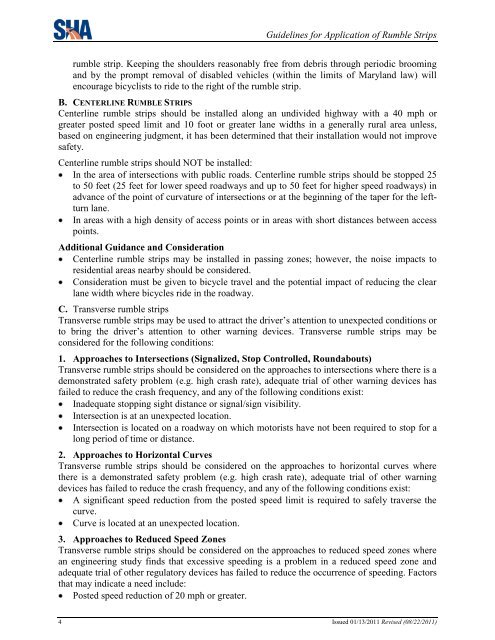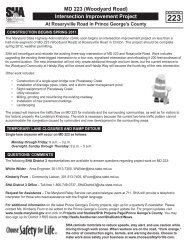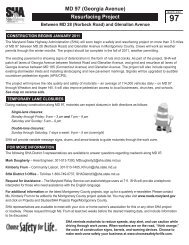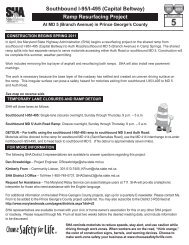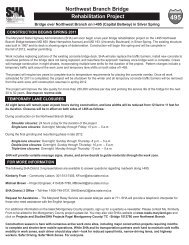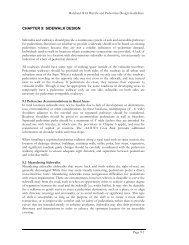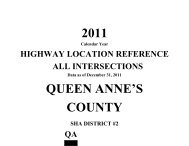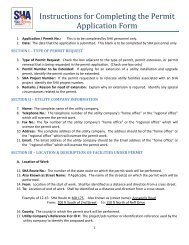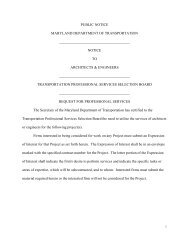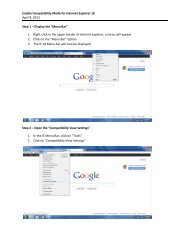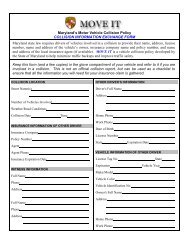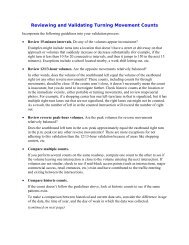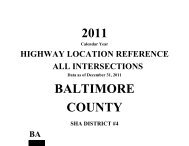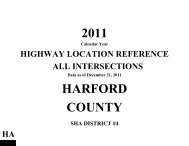Guidelines for Application of Rumble Strips and Rumble Stripes
Guidelines for Application of Rumble Strips and Rumble Stripes
Guidelines for Application of Rumble Strips and Rumble Stripes
Create successful ePaper yourself
Turn your PDF publications into a flip-book with our unique Google optimized e-Paper software.
<strong>Guidelines</strong> <strong>for</strong> <strong>Application</strong> <strong>of</strong> <strong>Rumble</strong> <strong>Strips</strong><br />
rumble strip. Keeping the shoulders reasonably free from debris through periodic brooming<br />
<strong>and</strong> by the prompt removal <strong>of</strong> disabled vehicles (within the limits <strong>of</strong> Maryl<strong>and</strong> law) will<br />
encourage bicyclists to ride to the right <strong>of</strong> the rumble strip.<br />
B. CENTERLINE RUMBLE STRIPS<br />
Centerline rumble strips should be installed along an undivided highway with a 40 mph or<br />
greater posted speed limit <strong>and</strong> 10 foot or greater lane widths in a generally rural area unless,<br />
based on engineering judgment, it has been determined that their installation would not improve<br />
safety.<br />
Centerline rumble strips should NOT be installed:<br />
In the area <strong>of</strong> intersections with public roads. Centerline rumble strips should be stopped 25<br />
to 50 feet (25 feet <strong>for</strong> lower speed roadways <strong>and</strong> up to 50 feet <strong>for</strong> higher speed roadways) in<br />
advance <strong>of</strong> the point <strong>of</strong> curvature <strong>of</strong> intersections or at the beginning <strong>of</strong> the taper <strong>for</strong> the leftturn<br />
lane.<br />
In areas with a high density <strong>of</strong> access points or in areas with short distances between access<br />
points.<br />
Additional Guidance <strong>and</strong> Consideration<br />
Centerline rumble strips may be installed in passing zones; however, the noise impacts to<br />
residential areas nearby should be considered.<br />
Consideration must be given to bicycle travel <strong>and</strong> the potential impact <strong>of</strong> reducing the clear<br />
lane width where bicycles ride in the roadway.<br />
C. Transverse rumble strips<br />
Transverse rumble strips may be used to attract the driver’s attention to unexpected conditions or<br />
to bring the driver’s attention to other warning devices. Transverse rumble strips may be<br />
considered <strong>for</strong> the following conditions:<br />
1. Approaches to Intersections (Signalized, Stop Controlled, Roundabouts)<br />
Transverse rumble strips should be considered on the approaches to intersections where there is a<br />
demonstrated safety problem (e.g. high crash rate), adequate trial <strong>of</strong> other warning devices has<br />
failed to reduce the crash frequency, <strong>and</strong> any <strong>of</strong> the following conditions exist:<br />
Inadequate stopping sight distance or signal/sign visibility.<br />
Intersection is at an unexpected location.<br />
Intersection is located on a roadway on which motorists have not been required to stop <strong>for</strong> a<br />
long period <strong>of</strong> time or distance.<br />
2. Approaches to Horizontal Curves<br />
Transverse rumble strips should be considered on the approaches to horizontal curves where<br />
there is a demonstrated safety problem (e.g. high crash rate), adequate trial <strong>of</strong> other warning<br />
devices has failed to reduce the crash frequency, <strong>and</strong> any <strong>of</strong> the following conditions exist:<br />
A significant speed reduction from the posted speed limit is required to safely traverse the<br />
curve.<br />
Curve is located at an unexpected location.<br />
3. Approaches to Reduced Speed Zones<br />
Transverse rumble strips should be considered on the approaches to reduced speed zones where<br />
an engineering study finds that excessive speeding is a problem in a reduced speed zone <strong>and</strong><br />
adequate trial <strong>of</strong> other regulatory devices has failed to reduce the occurrence <strong>of</strong> speeding. Factors<br />
that may indicate a need include:<br />
Posted speed reduction <strong>of</strong> 20 mph or greater.<br />
4 Issued 01/13/2011 Revised (08/22/2011)


